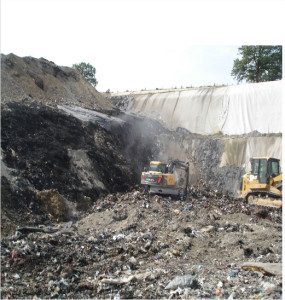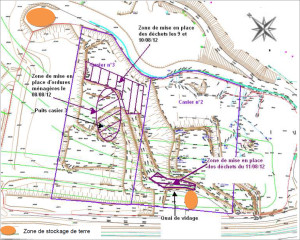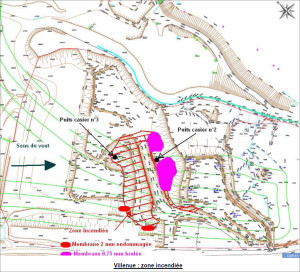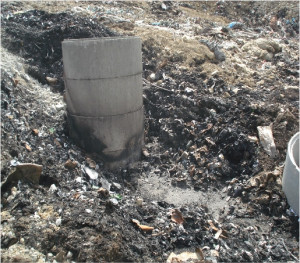Around noon on a hot windy summer day (>30°C, wind > 30 km/h), a motorcyclist noticed a smoke plume at a burial site (Non-Hazardous Waste Storage Facility) for waste and bulky items. He called to inform the town’s mayor, who had just received the same notification from a neighbour. The mayor alerted fire-fighters, who were denied access to the site due to a locked front gate (given the holiday, the site was unoccupied). The facility operator was called by the mayor and arrived at the scene around 12:30 pm to open the gate; 2 employees in a backhoe loader provided assistance. A mound of wastes between storage cells adjacent to the unloading dock was ablaze over 30 m². A subcontracted earthworks firm responded with a tractor and water tanker. Fire-fighters sprinkled the mound from a hose fed by the 3,000-m³ extinction water reserve; the backhoe was then used to cover the mound with earth while the other employee dumped earth on the nearby cell to prevent spreading. Fire-fighters installed a 2nd line around 2 pm and sprayed foam on the adjoining cell, where fire had already spread to the membrane and its protective geotextile (50% burned). Thick smoke, generated by combustion of old mattresses buried in the cell, reached neighbouring dwellings downwind, yet the toxicity measurements recorded by a chemical emergency squad proved negative. The fire was brought under control around 4:30 pm. Smothering the ignited area with earth continued until 11:30 pm; the 20 fire-fighters deployed left the site at 2 am the next morning. The facility’s active safety geotextile was burned over 200 m²; 3,000 m² of wastes combusted; the electrical supply line and external leachate pump discharge pipe were both damaged; and the ringed pipe inside the leachate well nozzle melted over 30 cm.
The gendarmerie had received no reports of a break-in, though the ignited waste burial zone had recently been opened (within the last 4 months); also, only a small amount of combustible biogas had been released. The investigation ordered by the operator revealed that household waste containing aerosol sprays and pieces of glass bottles had been placed in the storage cell 72 hours before the accident (around a leachate well). Since the block of waste was extremely dry (summer season, wind blowing), a magnifying glass effect of sunrays on the glass debris or the deposit of hot household waste (like barbecue ashes) was the likely cause of this outbreak. The site had already been the scene of a fire 16 months prior (ARIA 40305).
To improve fire prevention and protection, the operator: introduced a chain and padlock to close the gate, in providing access to first responders should a key be unavailable; set up a call centre to relay messages 24/7; and installed a 30-m³ water tank near the unloading dock to streamline an immediate response.







